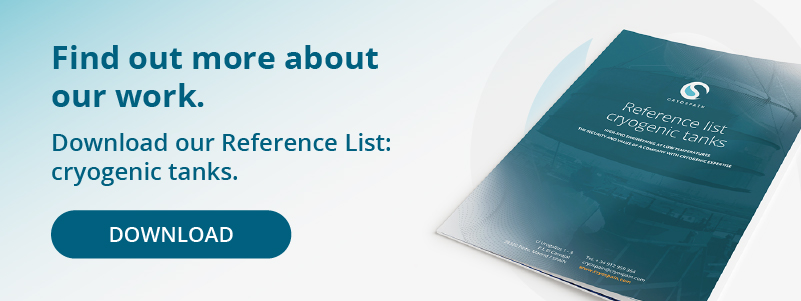Crucial design factors in vacuum-insulated piping
At Cryospain, we’re experts in the design and production of vacuum-insulated piping. This is thanks to cutting-edge technology and our sector-leading team of engineers
We are also experts in computational analyses of our customers’ systems. Stress calculation is one critical element in the design of vacuum-insulated piping.
Cryogenic piping can contract or expand as much as several millimeters per meter. It will come as no surprise that this generates significant stress. This crucial factor will influence decisions such as:
- routing
- pipe thickness
- support location
Furthermore, our customers use this type of piping in critical plants such as:
- LNG receiving terminal,
- air separation plants,
- LNG powered ships such as cruisers or ferries,
- hospitals and biotechnical facilities
With so much at stake, performance is critical. Our customers need their systems to work perfectly throughout their entire life cycle.
Keep reading: Cryoline: the ideal pipe system for the transportation of cryogenic liquids
Design and Loads
Cryospain always works side-by-side with our customers in plant design. Elements such as thermal loads are relatively easy to define. But cryogenic piping may be subject to more complex external loads. Ignore these, and they may affect performance in the long term.
A risk we can’t afford to ignore
Cryospain always strives for the best possible design. We look for solutions so that cryogenic plants aren’t too far away from our customer’s facilities. As a result, we can keep temperature changes to a minimum. This also improves the plants performance at critical moments. Furthermore, it makes them more resistant to often overlooked factors such as:
- Fatigue:
Behaviour will vary depending on the nature of each piping system. Pipes in operation 24/7/365 will always be cold. However, some pipes are warmed up and cooled down every day. Miscalculating these cycles could lead to early bellows failure.
- Surge analysis:
Some operations, like bunkering, involve quick opening of valves with high flows. The forces this “water hammer” causes need to be carefully calculated. They will affect our choices about support type and location as well as structure. This trend can bring very powerful forces to bear on pipe systems. Detailed surge analyses are also key, as they help avoid overdesign.
- Enforced displacement:
Unfortunately, structures are rarely completely rigid. In fact, significant enforced displacement will often need to be calculated. This is on top of any existing thermal displacement. Tall tower structures, tank connections, or ship systems often present this challenge.
Of course, other loads can also affect piping design. Wind, snow or seismic factors and bowing effect are all examples. But they are rarely relevant or out of the ordinary.
The right tools – Cryospain’s chosen calculation software
Our choice for these crucial calculations on VI piping design is AutoPIPE Advanced.
Why?
Cryospain has found it to be the most powerful and accurate software on the market. Firstly, its data input system is simple and intuitive. Secondly, it has the capacity to make transient load calculations. All the above gives us a comfortable safety margin and helps us avoid overdesign.
Cryogenic Piping Design: a team effort.
For Cryospain, design must involve both R&D and production departments. It is the only way to get the very best design for our customers’ cryogenic piping systems. And great design means great performance, regardless of the pipe’s lifecycle stage.
The next step is bringing all the above to life as real piping systems. This is where our industry-leading manufacturing and quality control process comes in.
From design to build, we’re with you every step of the way.











 Contacte-nos
Contacte-nos